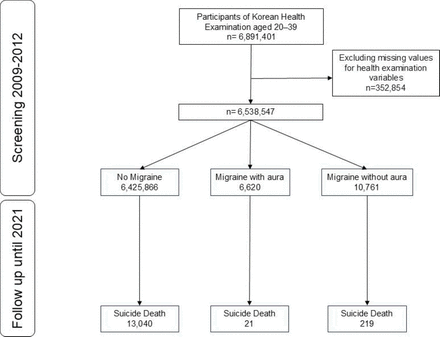Discussion
This nationwide population-based cohort study investigated the influence of migraine on the risk of suicide mortality in South Korean individuals aged 20–39. The key findings were as follows: (1) all migraine and migraine without aura were not associated with an increased risk of suicide compared with no migraine; (2) migraine with aura increased the risk of suicide; and (3) the presence of depression modified the effect of migraine on suicide risk, with a differential direction according to the migraine subtype.
Our study found no association between all migraine or migraine without aura and suicide risk compared with no migraine, addressing limitations of conflicting prior studies through a large, diverse population and extended follow-up period. Although some studies have explored the relationship between migraine and suicidal ideation or attempts, there is a notable lack of investigation of suicide itself as an outcome of migraine. Among the limited existing studies, Colman et al18 19 conducted a small population-based health survey revealing a similar suicide risk between those with and without a history of migraine headache (adjusted HR 0.60 (95% CI 0.22 to 1.65)).19 However, their study relied on subject recall for migraine diagnosis and had a heterogeneous age distribution among participants. Furthermore, Ilgen et al examined the data from the National Death Index and Department of Veterans Healthcare System treatment records, focusing on a 3-year follow-up period. They reported higher suicide risks among migraineurs compared with those in no migraine (unadjusted HR 1.68 (95% CI 1.28 to 2.20); adjusted HR 1.34 (95% CI 1.02 to 1.77)).18 However, the short follow-up duration of 3 years and the specific population studied limit the generalisability of their findings. In contrast, our study benefits from a longer follow-up period of approximately 11 years and encompasses a diverse study population, which includes individuals aged 20–39 years nationwide with varied demographic backgrounds and health statuses. Our study is the largest to date, identifying 240 suicides among individuals with migraine, including 21 in the migraine with aura subgroup. This substantially exceeds prior studies, which reported 138 and six suicides in migraine groups without specifically examining migraine with aura. Additionally, while previous studies faced similar limitations with administrative databases, our study addresses these gaps by incorporating covariates such as income, smoking status, exercise habits and depression. The use of a nationwide population-based dataset enhances representativeness and provides more comprehensive insights into this rare outcome of suicide mortality. These aspects enhance the generalisability and robustness of the results.
Unlike migraine or migraine without aura, migraine with aura was associated with an elevated risk of suicide. Migraine with aura, characterised by recurrent unilateral sensory or visual symptoms followed by a headache, may be linked to elevated suicidality.3 20 Lin et al found that migraine aura and depression severity predicted suicidal ideation among migraineurs, particularly in those experiencing high migraine frequency with aura.20 In addition, Breslau observed increased rates of suicide attempts and ideation among young adults with migraine with aura,21 whereas Wang et al reported that migraine with aura was linked to suicidal thoughts in adolescents.22 However, these studies primarily focused on suicidal thoughts and attempts, using cross-sectional designs, limiting their relevance in understanding actual suicidal mortality outcomes. Observations specifically targeting suicidal mortality outcomes have not yet distinguished subgroups within migraine with aura.18 19 However, our study has filled this gap by demonstrating an elevated risk of suicide mortality associated with aura. The pathophysiological mechanisms underlying the association between migraine with aura and elevated suicide risk may involve alterations in serotonin levels. Patients with migraine with aura exhibit lower plasma serotonin levels than those without aura and healthy controls.23 24 This dysregulation in serotonin levels may contribute to increased vulnerability to suicidal behaviours among individuals with migraine with aura.
Depression modified the association between migraine and suicide risk. Although depression is widely acknowledged as a major factor in suicide,25 26 its presence reduces the relative risk of suicide attributed to all migraine compared with that in its absence. Differential effects were noted across migraine subtypes; notably, a decreased risk among those with migraine without aura and an increased risk among those with migraine with aura and depression. Consistent with our findings, one nationwide inpatient cohort study demonstrated that migraine was associated with a 0.8-fold decreased odds of suicidal behaviours under the presence of depression, whereas among hospitalisations without depression, migraine was linked to a 2.35-fold increased odds of suicidal behaviours.27 Similarly, another study demonstrated a link between migraine and an increased likelihood of suicidal behaviour in their population, and the effect of migraine was significant in individuals without depression.28 Taken together, the risk of suicide in patients with migraine and depression is mostly driven by depression, whereas migraine itself may carry a neutral (as shown in our study) or at least potential risk of suicide in those without depression. The fact that the increased risk of suicide associated with migraine with aura reverted to a protective effect in our study suggests that migraine sufferers with diagnosed psychiatric disorders might be receiving effective care that mitigates their risk of suicide.
The strength of this study lies in its nationwide analysis, which investigated the impact of migraine on suicide mortality, leveraging a comprehensive dataset from the KHE, NHIS and the Korean National Statistical Office. This ensured a relatively unbiased population and provided valuable big data for analysis. We recognise that the number of deaths in the migraine with aura group is relatively small, particularly when examining suicide as an outcome, which is inherently rare. This small sample size can lead to statistical instability, as reflected in the wide CIs of the HRs. These wide intervals suggest potential variability in the results and increase the likelihood of type 2 error. Despite this, our analysis rejected the null hypothesis, indicating that the association we observed between migraine with aura and suicide mortality remains statistically significant. The large-scale nature of our dataset allowed us to detect these cases, offering insights that smaller studies may have missed.
This study had several limitations. First, migraine diagnosis relies on ICD codes, which may introduce the risk of inaccurate classification. In our study, the use of the G43 (migraine) code to define migraine yielded a prevalence of approximately 1.74%, which is significantly lower than the strictly defined migraine prevalence of around 6%.29 Therefore, our study suggests the potential for underdiagnosing migraine, which is a phenomenon not limited to Korea but observed globally.30 Further narrowing the definition of migraine beyond ICD codes poses a risk of bias in the research, as it could exacerbate the issue of underdiagnosis. Furthermore, G439 (unspecified migraine), included in the migraine without aura group, may involve the misclassification of cases of G431 (migraine with aura). This misclassification could introduce a conservative bias, potentially overestimating the suicide risk in the migraine without aura group while underestimating it in the migraine with aura group. Nevertheless, our findings show no significant association for migraine without aura, whereas the significant association observed for migraine with aura suggests that the increased suicide risk is likely robust and may even underestimate the true strength of the relationship. Additionally, the lack of detailed information on migraine severity, frequency and duration limits the depth of understanding of the relationship between migraine and suicide risk. This study is further limited by unaccounted covariates (familial problems, work-related problems, genetic predisposition, family history of mental illness and other factors) that were unavailable due to the limitations of a large-scale database; however, we aimed to strengthen the model’s robustness by including key covariates such as income, smoking, drinking and depression. Moreover, the observational nature of the study prevents the establishment of causality, and residual confounding factors may still affect the results despite adjustments in the analysis. While our study focuses on the association between migraine and suicide mortality, it is limited by only examining completed suicides and not capturing suicidal ideation or attempts. This approach may exclude other critical aspects of suicidal behaviour, such as ideation and attempts, which differ by sex and other factors. However, our analysis showed no significant differences between males and females in the association between migraine and suicide risk (p for interaction=0.2729). Additionally, when including migraine subtypes, the interaction remained non-significant (p for interaction=0.5818). Finally, the generalisability of the findings may be restricted to the Korean population, and caution should be exercised when extrapolating the findings to other ethnic or cultural groups. Although the dataset offers valuable insights from a large-scale population, it included 6 539 547 participants aged 20–39 in 2012, representing 43.9% of this demographic group. As it primarily includes employed individuals covered by the National Health Insurance and excludes non-working groups such as students and homemakers, representativeness may be limited.


